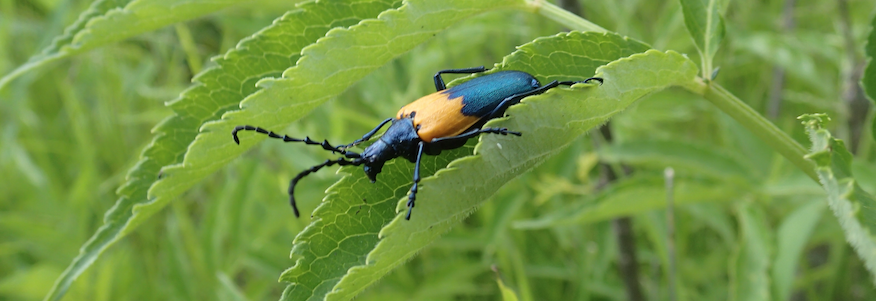

Color in the field!
As spring rains give way to warm, sunny days, the meadows of Mount Rogers come to life with the emergence of a plethora of insects. Among these creatures is a beetle with a striking iridescent blue body and a yellow-orange wash across its elytra (forewings).

Lemon Plagodis
This morning I found three Lemon Plagodis and an Oak Besma perched on a Velcro strap that holds my moth sheet tight. Enjoy!

Cecropia
Hyalophora Cecropia isn't a moth that I expected to see at my moth light here in the mountains. I had a brief glimpse of one in Lake Waccamaw State Park in North Carolina fourteen years ago today (5/20/14). The only time I had one to examine up close and personal, I was a kid on the family farm in Delaware, 60+ years ago. Cecropias are the largest of our North American silkmoths and they are spectacular in their own right. Enjoy the pics!

Calico Pennant
Last Wednesday (5?14/14) my wife and I found a number of active dragonflies at Bass Lake on the outskirts of Blowing Rock, Watauga County, NC. We saw eastern pondhawks, common whitetails, Carolina saddlebags, and Calico pennants. The pennants sat still long enough for me to get a decent photo. Enjoy!


Ailanthus
In my neck of the woods, Ailanthus is an invasive alien that looks like a native, but isn't. One of the reasons that homeowners like it is the flowers. Moth enthusiasts know about it because Atteva aurea, the Ailanthus webworm, uses it as its host plant. Here's the photographic evidence.


When a digital photo really helps
Identifying insects (and other critters) is a reasonable method most of the time, but sometimes is impossible. An example is the Geometer moth genus Hydriomena. There are probably several species in our area, but the color and patterns on the wings are highly variable and cannot be used safely to distinguish species.

Chasing Tigers in the Blue Ridge
In the Central Virginia Blue Ridge exists a phenomenal ecosystem, one that was probably shaped by raging braided mountain streams during the last iceage. It contains many disjunct species. In fact, over 90 species that are well outside their typical range have been documented here. It’s an odd mix of coastal plain, Appalachian and northern plants and animals. While several rare and endangered species exist here, today we focused on a well known Blue Ridge phenomenon: Salamanders.

Plethodon complex salamander
Yesterday, March 12, I photographed a salamander in the yard. After I did an initial search for an ID, I sent the photos to Bill Dunson. He forwarded them to a couple of experts and recommended that I send the pics to the president of the Virginia Herpetological Society, which I did.

Snow and Birds on March 7
Today, March 7, was a good day to stay inside, enjoy the falling snow, and watch the birds. The first unexpected arrivals were red-winged blackbirds, three of them—a female and two first-winter males. The first photo shows the female.

FINALLY...The Elusive Red Crossbill
In the birding world, folks talk about their nemesis bird, the one that got away, that elusive, irritating species that everyone else sees but you. Bragging rights and chest pounding are not uncommon.

Fox Squirrel
The fox squirrel that first appeared in the yard on December 12 continues to return periodically. This morning, Christmas Eve, it came to the pole feeder in front of the study window, enabling me to take a photo in spite of the cloudy weather.

Caterpillars and Pupae
Now that the weather has turned hostile to insects and other arthropods, it's time to empty my folder of stuff to post. I collected a number of caterpillars this fall and have a box of moist potting soil that has the resulting pupae. Some I identified and some not. Here's one that I couldn't decipher.